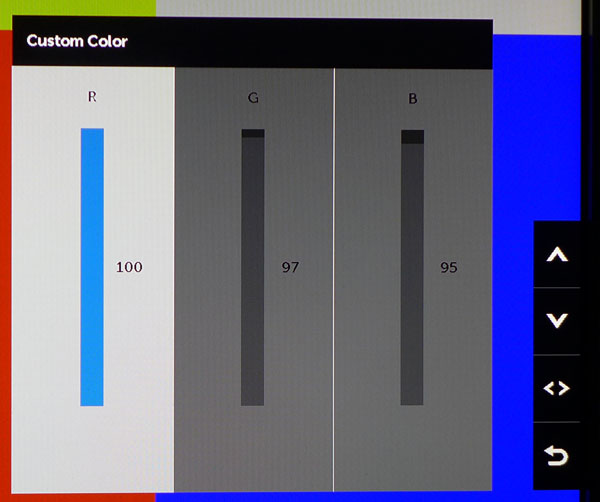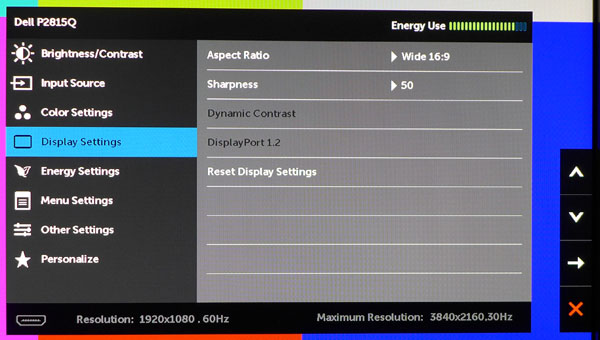Dell P2815Q 28-Inch 4K Ultra HD Monitor Review
Putting a 4K monitor on your desktop means either spending four figures on a 32-inch IGZO screen or going on the cheap with one of the new 28-inch TN-based models. We already reviewed Asus’ PB287Q. Today we look at Dell’s version, the P2815Q.
Why you can trust Tom's Hardware
OSD Setup And Calibration Of The Dell P2815Q
The P2815Q’s OSD looks just like every other Dell monitor we’ve encountered, except that it's much simpler. Only basic image adjustments are provided, along with the usual convenience functions.
OSD Tour
Pressing the control button right above Power brings up a quick menu.
The first two options can be changed in the OSD if you wish. Here, they’re set to change picture modes or adjust brightness and contrast. Pressing the third button opens the full OSD.
The control buttons aren’t labeled, but the screen always shows their functions with easy-to-understand icons. Brightness modulates the backlight and, like contrast, ranges from zero to 100. Each click represents about 3cd/m2.
Here, you can change your input source. We used the bundled mini-DisplayPort interface to connect to our test PC and the HDMI port for the performance tests.
Input Color Format comes correctly set to RGB from the factory. If you use a Blu-ray player that only outputs YCbCr, you should change this setting accordingly. To access the white balance controls, select the Custom Color picture mode.
The P2815Q offers eight picture modes. In Movie or Game, saturation and hue adjustments are unlocked. When you select Custom Color, the RGB sliders appear.
Get Tom's Hardware's best news and in-depth reviews, straight to your inbox.
The sliders start at their maximums, which means any adjustment reduces contrast. Fortunately, we didn’t have to tweak them too much. In fact, the P2815Q is quite accurate without calibration, so you might not have to manipulate them at all.
Aspect Ratio choices are 16:9 (all resolutions are scaled to fill the screen), 4:3 or 1:1 (pixel-mapped). Sharpness adds edge enhancement, which, at the P2815Q’s native resolution, completely hides fine detail. The default setting of 50 looked alright on our sample.
Dynamic Contrast only works in the Game or Movie modes. It can crush highlight and shadow detail, so use it carefully.
To use the DisplayPort multi-stream feature, set the 1.2 option to Enable. Unfortunately, it won’t enable a 60Hz refresh rate at 3840x2160.
You can see the Energy Use bar in the top-right of the OSD menus. Turning off the power button LED and USB ports can save a bit of juice in standby mode.
The OSD comes in eight languages. If you rotate the P2815Q to portrait mode, you can flip the menu as well. Transparency lets you make the menu opaque or partially transparent and Timer keeps the OSD on-screen for up to 60 seconds.
To control access to adjustments, turn on the Lock feature. Press and hold the lowest bezel key for 10 seconds to unlock.
To allow two-way communication between the P2815Q and your PC, enable DDC/CI. LCD Conditioning runs a series of test patterns designed to mitigate image retention, which is not an issue with LCD panels.
Finally, you can reset all OSD parameters to their factory defaults.
The first two bezel keys are programmable in the Personalize menu. You can have quick access to Picture Mode, Brightness & Contrast, Input Source, Aspect Ratio, and OSD Rotation.
Calibration
The only picture mode that allows a white balance adjustment is Custom Color. Since the P2815Q is already quite close to D65 in its Standard mode, we could only make a slight improvement. Because the RGB sliders start at their maximums, calibration reduced on/off contrast by 18 percent on our sample. You may wish to forgo adjustment to realize the monitor’s full contrast ratio and simply adjust Brightness to taste. The Contrast control won’t clip signal information until it reaches level 79.
| Dell P2815Q Calibration Settings | |
|---|---|
| Brightness | 89 |
| Contrast | 70 |
| Custom Color | Red 100, Green 97, Blue 95 |
Current page: OSD Setup And Calibration Of The Dell P2815Q
Prev Page Packaging, Physical Layout, And Accessories Next Page Results: Brightness And Contrast
Christian Eberle is a Contributing Editor for Tom's Hardware US. He's a veteran reviewer of A/V equipment, specializing in monitors. Christian began his obsession with tech when he built his first PC in 1991, a 286 running DOS 3.0 at a blazing 12MHz. In 2006, he undertook training from the Imaging Science Foundation in video calibration and testing and thus started a passion for precise imaging that persists to this day. He is also a professional musician with a degree from the New England Conservatory as a classical bassoonist which he used to good effect as a performer with the West Point Army Band from 1987 to 2013. He enjoys watching movies and listening to high-end audio in his custom-built home theater and can be seen riding trails near his home on a race-ready ICE VTX recumbent trike. Christian enjoys the endless summer in Florida where he lives with his wife and Chihuahua and plays with orchestras around the state.










